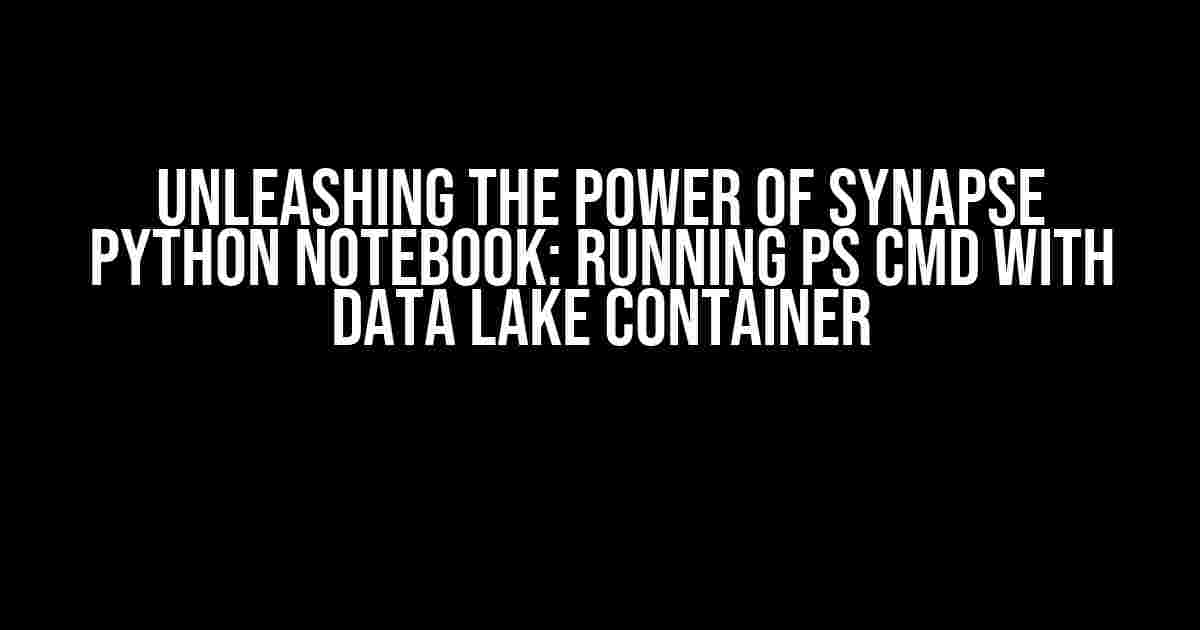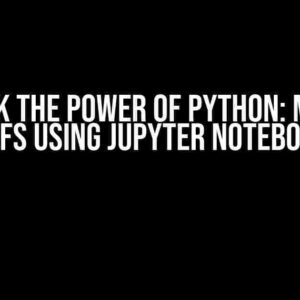Are you tired of struggling to integrate your PowerShell commands with Synapse Python Notebook? Do you want to unlock the full potential of your data lake container by passing file paths as input parameters? Look no further! In this comprehensive guide, we’ll take you by the hand and walk you through the process of running a PS cmd in Synapse Python Notebook, where the executable is stored in a data lake container and uses a file path from the same container as an input parameter.
- Prerequisites
- Step 1: Configure Your Data Lake Container
- Step 2: Install Required Libraries in Your Synapse Python Notebook
- Step 3: Authenticate with Your Azure Storage Account
- Step 4: Download the PowerShell Executable and Input File
- Step 5: Run the PowerShell Command
- Putting it all Together
- Conclusion
- Troubleshooting Tips
Prerequisites
Before we dive into the meat of the article, make sure you have the following:
- A Synapse workspace set up with a Python notebook
- A data lake container with the PowerShell executable (e.g., `ps.exe`) and the input file
- Basic knowledge of PowerShell and Python
Step 1: Configure Your Data Lake Container
In this step, we’ll ensure that your data lake container is properly set up and accessible from your Synapse Python notebook.
a. Create a Data Lake Container
If you haven’t already, create a data lake container in your Azure storage account. This will serve as a centralized repository for your PowerShell executable and input files.
b. Upload the PowerShell Executable
Upload the PowerShell executable (`ps.exe`) to your data lake container. This executable will be used to run your PowerShell commands.
c. Upload the Input File
Upload the input file that will be used as a parameter for your PowerShell command. This file should be stored in the same data lake container as the PowerShell executable.
Step 2: Install Required Libraries in Your Synapse Python Notebook
In this step, we’ll install the necessary libraries to interact with your data lake container and run PowerShell commands.
!pip install azure-storage-blob
!pip install azure-identity
These libraries will allow you to authenticate with your Azure storage account and interact with your data lake container.
Step 3: Authenticate with Your Azure Storage Account
In this step, we’ll authenticate with your Azure storage account using the Azure Identity library.
from azure.identity import DefaultAzureCredential
from azure.storage.blob import BlobServiceClient
credential = DefaultAzureCredential()
blob_service_client = BlobServiceClient("https://.blob.core.windows.net", credential=credential)
Replace `
Step 4: Download the PowerShell Executable and Input File
In this step, we’ll download the PowerShell executable and input file from your data lake container using the BlobServiceClient.
blob_client = blob_service_client.get_blob_client("path/to/ps.exe")
with open("ps.exe", "wb") as file:
file.write(blob_client.download_blob().readall())
blob_client = blob_service_client.get_blob_client("path/to/input_file.txt")
with open("input_file.txt", "wb") as file:
file.write(blob_client.download_blob().readall())
Replace `”path/to/ps.exe”` and `”path/to/input_file.txt”` with the actual paths to your PowerShell executable and input file in your data lake container.
Step 5: Run the PowerShell Command
In this step, we’ll use the `subprocess` library to run the PowerShell command with the input file as a parameter.
import subprocess
ps_command = ["./ps.exe", "Command", "-InputFile", "input_file.txt"]
process = subprocess.run(ps_command, capture_output=True, text=True)
print(process.stdout)
Replace `”Command”` with the actual PowerShell command you want to run. The `-InputFile` parameter specifies the input file path, which is stored in the same data lake container.
Putting it all Together
Here’s the complete code snippet that integrates all the previous steps:
from azure.identity import DefaultAzureCredential
from azure.storage.blob import BlobServiceClient
import subprocess
# Authenticate with Azure storage account
credential = DefaultAzureCredential()
blob_service_client = BlobServiceClient("https://.blob.core.windows.net", credential=credential)
# Download PowerShell executable and input file
blob_client = blob_service_client.get_blob_client("path/to/ps.exe")
with open("ps.exe", "wb") as file:
file.write(blob_client.download_blob().readall())
blob_client = blob_service_client.get_blob_client("path/to/input_file.txt")
with open("input_file.txt", "wb") as file:
file.write(blob_client.download_blob().readall())
# Run PowerShell command
ps_command = ["./ps.exe", "Command", "-InputFile", "input_file.txt"]
process = subprocess.run(ps_command, capture_output=True, text=True)
print(process.stdout)
Conclusion
Voilà! You’ve successfully run a PS cmd in Synapse Python Notebook, where the executable is stored in a data lake container and uses a file path from the same container as an input parameter. This integration unlocks a wealth of possibilities for automating complex workflows and processing large datasets.
Troubleshooting Tips
If you encounter any issues, check the following:
- Ensure that the PowerShell executable and input file are correctly uploaded to your data lake container.
- Verify that the Azure Identity library is correctly installed and authenticated.
- Check the file paths and names in your code snippet to ensure they match the actual file locations.
| Keyword | Description |
|---|---|
| PS cmd | PowerShell command |
| Synapse Python Notebook | A Python notebook environment in Azure Synapse Analytics |
| Data Lake Container | A centralized repository for storing and managing data in Azure Synapse Analytics |
We hope this comprehensive guide has helped you overcome the challenges of running PS cmd in Synapse Python Notebook with a data lake container. Happy coding!
Frequently Asked Question
Get ready to unleash the power of Synapse Python Notebook and Data Lake containers! Here are some frequently asked questions about running a PS cmd in Synapse Python Notebook and passing file paths as input parameters.
Q1: How can I run a PS cmd in Synapse Python Notebook?
You can run a PS cmd in Synapse Python Notebook using the `!` command. For example, `! cmd /c “powershell.exe YourScript.ps1″` will execute the PowerShell script `YourScript.ps1`.
Q2: How can I access files in a Data Lake container from my Synapse Python Notebook?
You can access files in a Data Lake container using the `spark` instance in your Synapse Python Notebook. For example, `spark.read.format(“csv”).load(“abfss://[email protected]/yourfile.csv”)` will read a CSV file from the specified Data Lake container.
Q3: How can I pass a file path from a Data Lake container as an input parameter to my PS cmd in Synapse Python Notebook?
You can use the `uri` module to construct the file path and pass it as an argument to your PS cmd. For example, `from urllib.parse import quote; file_path = “abfss://[email protected]/yourfile.csv”; ! cmd /c “powershell.exe YourScript.ps1 -InputFile {}” .format(quote(file_path))` will pass the file path as an input parameter to your PowerShell script.
Q4: Can I use a Data Lake container as a working directory for my PS cmd in Synapse Python Notebook?
Yes, you can use a Data Lake container as a working directory for your PS cmd in Synapse Python Notebook. For example, `! cmd /c “cd /D abfss://[email protected] && powershell.exe YourScript.ps1″` will set the working directory to the specified Data Lake container before executing the PowerShell script.
Q5: Are there any security considerations I should be aware of when running PS cmd in Synapse Python Notebook with Data Lake containers?
Yes, you should be aware of the security implications of running PS cmd in Synapse Python Notebook with Data Lake containers. Make sure to follow best practices for secure coding and data access, and ensure that your PowerShell scripts are properly validated and sanitized to prevent any potential security risks.




